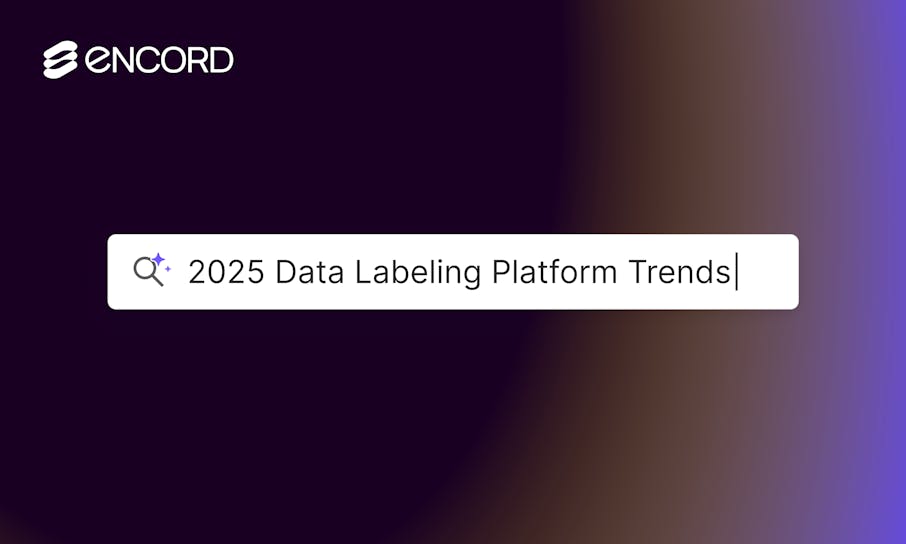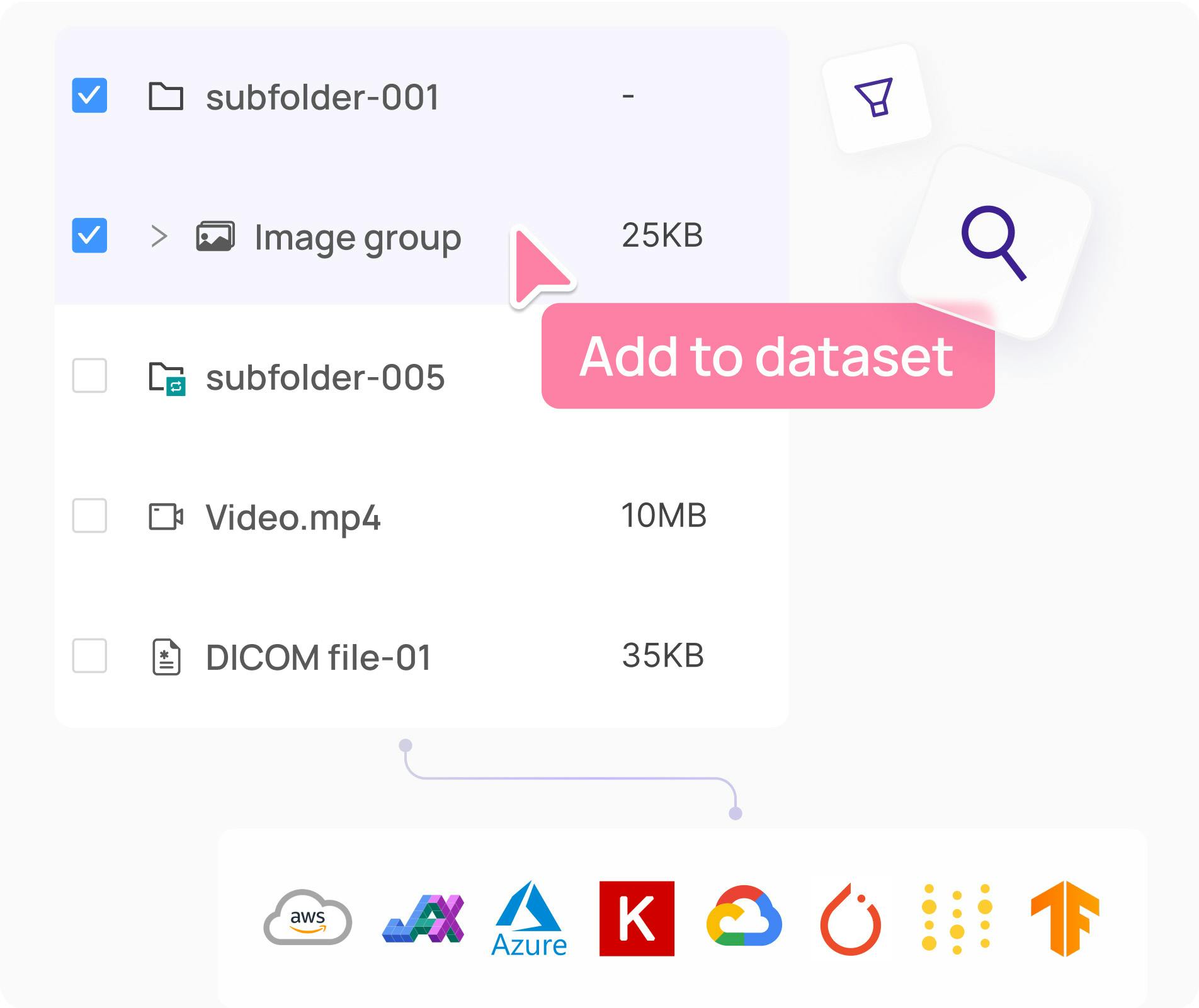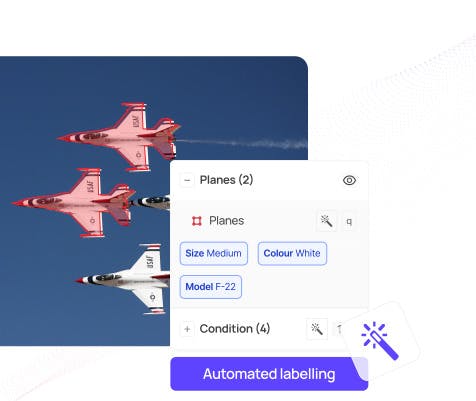Contents
Key Data Labeling Trends in 2025
Benchmarking Data Labeling Platforms
Workflows & Automation Insights
Actionable Recommendations for ML/AI Teams
Key Takeaways
Encord Blog
2025 Data Labeling Platform Trends: Tools, Workflows, and Automation Insights for ML Teams
5 min read

In 2025, the best data labeling platforms combine AI automation with human oversight to deliver faster, more accurate, and lower-cost labeling.
Teams using hybrid workflows report up to 5× faster throughput and 30–35% cost savings while improving accuracy.
Leading examples from OnsiteIQ, Pickle Robot, and Automotus show how AI-assisted labeling and analytics-driven workflows now define the industry standard.
Smart automation isn’t just about speed, but also about building scalable, high-quality data pipelines that power better models.
Selecting the right data labeling platform is critical for any machine learning team. The quality, speed, and accuracy of your labeled datasets directly impact model performance, making platform choice a strategic decision for ML teams.
In recent years, the adoption of AI-assisted automation and hybrid workflows has accelerated, allowing teams to scale labeling efforts while maintaining high accuracy.
This report dives into the latest trends in data labeling platforms, combining first-hand customer experiences with actionable insights. From workflow efficiency to tool adoption, we provide AI leaders with the data they need to make informed decisions and optimize their labeling processes.
Whether you are evaluating platforms for your next project or looking to enhance current workflows, the insights shared here are designed to guide smarter, faster, and more effective training data prep.
Key Data Labeling Trends in 2025
The data labeling landscape is evolving rapidly, driven by advances in AI, automation, and increasingly complex datasets. For AI teams, understanding these trends is essential for selecting the right data labeling platform and optimizing workflows.
1. Rise of AI-Assisted Labeling
AI-assisted labeling, such as SAM2 integration, is becoming a core feature of modern data labeling platforms. By using machine learning models to pre-label data, teams can significantly reduce manual effort, accelerate throughput, and maintain higher consistency across large datasets.
OnsiteIQ, a construction intelligence company using computer vision for site safety and quality inspections, migrated their data workflows to Encord after facing limitations with a legacy annotation platform. Their previous tool struggled with poor usability, underperforming automation, and lengthy setup times, all of which slowed model development.
After adopting Encord’s AI-assisted data labeling platform, the impact was immediate and measurable:
- 5× improvement in data throughput, enabling faster model iteration cycles.
- 4× faster project setup, reducing implementation time from two months to just two weeks.
- 75% reduction in time to value, cutting onboarding and configuration costs.
- Significant decrease in labeling costs through automation features like SAM 2 for smart pre-labeling.
- Enhanced team management via integrated analytics dashboards for monitoring throughput, user activity, and labeling performance in real time.
Platform Benchmark Insights
OnsiteIQ’s migration illustrates broader trends across the industry:
- Automation directly scales output: AI-assisted labeling platforms can deliver up to 5× faster throughput compared with manual or semi-manual systems.
- Setup efficiency matters: user-friendly interfaces and workflow templates can cut configuration times by 70–80%, accelerating time to value.
2. Hybrid vs. Fully Automated Workflows
While full automation is ideal in theory, most organizations are adopting hybrid workflows that combine human expertise with AI assistance. This is especially true in domains that require expert labeling knowledge, like healthcare AI.
Hybrid workflows allow teams to handle complex edge cases that fully automated systems struggle with, while still gaining efficiency from AI pre-labeling. Our data shows that hybrid approaches improve labeling speed without compromising quality, making them the preferred workflow for teams managing high-stakes or nuanced datasets.
3. LiDAR and 3D Labeling
As autonomous vehicles, robotics, and AR/VR applications expand, LiDAR and 3D data labeling are becoming increasingly important. These datasets require specialized platforms capable of handling point clouds and 3D annotation. Platforms supporting 3D labeling with integrated AI tools are helping teams accelerate annotation while maintaining precision—a critical factor for safety-critical applications like autonomous driving.
Benchmarking Data Labeling Platforms
To help ML and AI teams navigate an increasingly crowded market, we outlined how to benchmark data labeling platforms using a combination of customer success metrics and external market research. The evaluation focused on four key performance indicators: labeling speed, accuracy, cost per annotation, and automation capabilities.
Speed
Speed remains a decisive factor in large-scale annotation projects.
For example, Archetype AI, the first developer platform for Physical AI enabling enterprises to build and deploy custom AI applications for the physical world, used Encord to double annotation speed.
This has allowed the team to work far more efficiently than with previous tooling. This improvement is driven by Encord’s fast and intuitive annotation tools, powerful features like trackers and bulk operations, and most importantly, the flexibility of Encord's SDK, which enabled the team to build custom ETL pipelines for seamless data ingestion and annotation retrieval. Tasks that previously required manual upload/download steps and browser-heavy interactions are now fully streamlined. Together, these capabilities have drastically streamlined Archetype AI’s end-to-end labeling workflow.
Accuracy and Error Rates
Accuracy varies depending on dataset complexity and workflow type.
A standout example comes from Pickle Robot, a Cambridge-based Physical AI company automating warehouse unloading through advanced robotics. The team faced significant accuracy challenges with their previous outsourced labeling setup, such as overlapping polygons, incomplete labels, and unreliable automation created cascading errors that slowed training and required extensive manual auditing.
After migrating to Encord’s AI-assisted data labeling platform, Pickle Robot built a fully integrated, high-precision data pipeline. By leveraging granular annotation tools, nested ontologies, and hybrid human-in-the-loop (HITL) workflows, they achieved measurable accuracy improvements:
- 30% increase in annotation accuracy, eliminating overlapping and incomplete labels
- 15% boost in robotic grasping precision, translating directly to safer and more efficient automated unloading
- 60% faster iteration cycles on training data for new learning tasks
- Fewer audit loops, freeing engineers to focus on model development instead of error correction
This case highlights how hybrid, AI-assisted labeling workflows consistently outperform traditional manual methods.
Cost per Annotation
Cost efficiency is often the deciding factor when selecting a data labeling platform, especially for organizations managing vast, continuously growing image or video datasets. While automation can improve speed and accuracy, its greatest advantage often lies in reducing the cost per annotation.
A clear example of this is Automotus, a company using AI and computer vision to optimize urban parking and traffic management. With hundreds of cameras capturing de-identified street-level imagery, Automotus faced a common but costly challenge: labeling everything wasn’t practical, and much of the data held limited value for model improvement.
By migrating their full data pipeline, spanning automated data curation, AI-assisted labeling, and model evaluation, to Encord’s data labeling platform, Automotus was able to:
- Reduce the dataset size for annotation by 35%, eliminating low-value data before labeling began
- Cut labeling costs by over 33% through intelligent data selection and automation
- Streamline quality control with human-in-the-loop feedback and flexible ontology management, improving precision for small, complex objects
- Accelerate project turnaround times with assisted labeling, allowing annotators to label only key frames and rely on automation for the rest
Automation and Workflow Features
The most advanced data labeling platforms now integrate features like:
- AI-powered pre-labeling and auto-correction
- Active learning for model-driven sampling
- Integrated quality assurance dashboards
- Real-time collaboration and review pipelines
Platforms combining these automation features with human-in-the-loop validation offered the best overall performance balance.
Workflows & Automation Insights
Efficient workflows are at the core of every high-performing data labeling platform.
Based on our analysis, three main workflow types dominate current practice:
1. Manual Workflows
Manual labeling remains valuable for complex datasets that require contextual judgment, such as medical imaging or sentiment analysis. However, scalability is limited, and costs are higher without automation support.
2. Semi-Automated Workflows
Semi-automated workflows combine automation with human-in-the-loop (HTIL). AI models handle repetitive labeling tasks while annotators correct edge cases, striking a balance between speed and quality.
3. Fully Automated Workflows
In mature domains (e.g., image segmentation, simple object detection), fully automated pipelines are emerging. These depend heavily on model confidence scoring and continuous retraining but can deliver exceptional speed once properly tuned.
Actionable Recommendations for ML/AI Teams
Choosing the right data labeling platform depends on your project’s size, dataset type, and automation readiness. Below are practical recommendations based on our findings:
1. Match Platform Features to Dataset Complexity
- Use AI-assisted platforms for repetitive or structured data (e.g., image segmentation, OCR).
- For niche or context-heavy datasets, prioritize platforms with advanced review and QA tools.
2. Adopt Hybrid Workflows Early
Hybrid workflows which combine AI-assisted pre-labeling with human-in-the-loop (HITL) validation represent the sweet spot for efficiency and quality. By letting AI handle repetitive or predictable labeling tasks while humans focus on edge cases and complex data, teams can dramatically increase throughput without sacrificing accuracy.
Real-world examples highlight the impact:
- OnsiteIQ implemented Encord’s hybrid workflow and achieved 5× faster data throughput while maintaining high-quality annotations. Human review was only required for exceptions, allowing their team to focus on model refinement rather than repetitive labeling tasks.
- Pickle Robot leveraged AI-assisted labeling in combination with granular human oversight to improve annotation precision by 30% and reduce iteration cycles on new models by 60%.
Best Practices for Implementing Hybrid Workflows:
- Start AI pre-labeling early: Feed initial model predictions into the pipeline to reduce manual effort.
- Define human review criteria: Reserve human annotation for complex or low-confidence cases.
- Continuously retrain models: Use human-corrected labels to improve automation over time.
- Integrate analytics dashboards: Monitor throughput, error rates, and confidence scores to optimize workflow allocation.
3. Evaluate Automation Beyond Marketing Claims
Key metrics to evaluate a data labeling platform include:
- Labeling speed (labels/hour): How many items can the platform process reliably per hour with and without human review?
- Model confidence scores: Does the platform provide guidance on which labels require human oversight?
- QA review time: How much human effort is required to audit automated labels for accuracy?
Customer Examples:
- Automotus used Encord to combine AI-assisted labeling with data curation, reducing their dataset size by 35% and cutting labeling costs by over 33%. They could measure precisely which frames required human review, avoiding wasted annotation effort.
- Pickle Robot integrated AI-assisted workflows with detailed auditing dashboards, enabling engineers to identify and correct errors quickly, improving annotation accuracy by 30% and speeding up iteration cycles by 60%.
Best Practices for Evaluating Automation:
- Test with a representative subset of your data to measure speed and accuracy gains.
- Evaluate how well human-in-the-loop tools integrate with AI predictions.
- Track downstream model performance to ensure automation improves, rather than compromises, results.
- Compare multiple platforms using the same metrics to make data-driven platform selection decisions.
By rigorously evaluating automation, teams can ensure that a data labeling platform actually delivers real efficiency and accuracy improvements.
4. Checklist: Evaluating a Data Labeling Platform
- Does it support hybrid or AI-assisted labeling?
- Are QA and review tools integrated?
- Can it handle your dataset type (text, image, 3D, LiDAR)?
- How easily can it scale across projects or regions?
- What are the measurable efficiency and accuracy gains?
Key Takeaways
- AI-assisted labeling is now standard in modern data labeling platforms, improving efficiency and lowering costs.
- Hybrid workflows strike the best balance between speed and accuracy.
LiDAR and 3D labeling are rapidly growing segments, demanding specialized tooling. - Teams that strategically evaluate platforms based on performance data—not just features—gain a competitive advantage in model development speed and dataset quality.
By leveraging benchmark data and automation insights, ML/AI leaders can select the right data labeling platform to accelerate annotation pipelines and strengthen model outcomes.
Explore the platform
Data infrastructure for multimodal AI
Explore product
Explore our products
- A data labeling platform is a software solution that helps machine learning teams annotate data, such as images, text, audio, or LiDAR, so that AI models can be trained effectively. Modern platforms include AI-assisted tools, automation pipelines, and analytics dashboards to improve speed and accuracy.
- Labeling quality directly impacts model accuracy. Poorly labeled or inconsistent data can introduce bias and degrade model performance. The right data labeling platform ensures that data is clean, consistent, and efficiently annotated for scalable AI training.
- AI-assisted labeling and automation-first workflows are now standard. Hybrid human + AI workflows outperform both manual and fully automated systems. 3D and LiDAR data labeling are growing due to autonomous and robotics applications. Integrated active learning and quality assurance tools are now essential for real-time feedback and retraining.
- Evaluate platforms across four dimensions: Speed (labels/hour) Accuracy / error rate Cost per annotation Automation and workflow flexibility Case studies from OnsiteIQ, Pickle Robot, and Automotus demonstrate that platforms offering AI-assisted workflows and integrated analytics outperform legacy tools across all four.
- Manual: Humans label every data point, high accuracy, low scalability. Semi-automated: AI assists with repetitive tasks, humans verify outputs. Hybrid (best practice): AI pre-labels and humans correct errors, optimizing for both speed and precision.
- Focus on data curation and intelligent sampling, label only high-value or uncertain data. Platforms like Encord help automate this process, as seen in Automotus’ 35% dataset reduction and 33% cost savings through smart data selection and assisted labeling.
- AI-assisted labeling and pre-labeling tools Human-in-the-loop (HITL) review workflows Flexible ontology and data management Real-time QA dashboards and metrics SDK or API integration for automated data pipelines
- The future is model-in-the-loop automation, where labeling, training, and evaluation are continuous and connected. Teams that invest now in hybrid, analytics-driven platforms will lead in model iteration speed, scalability, and data quality by 2026 and beyond.


